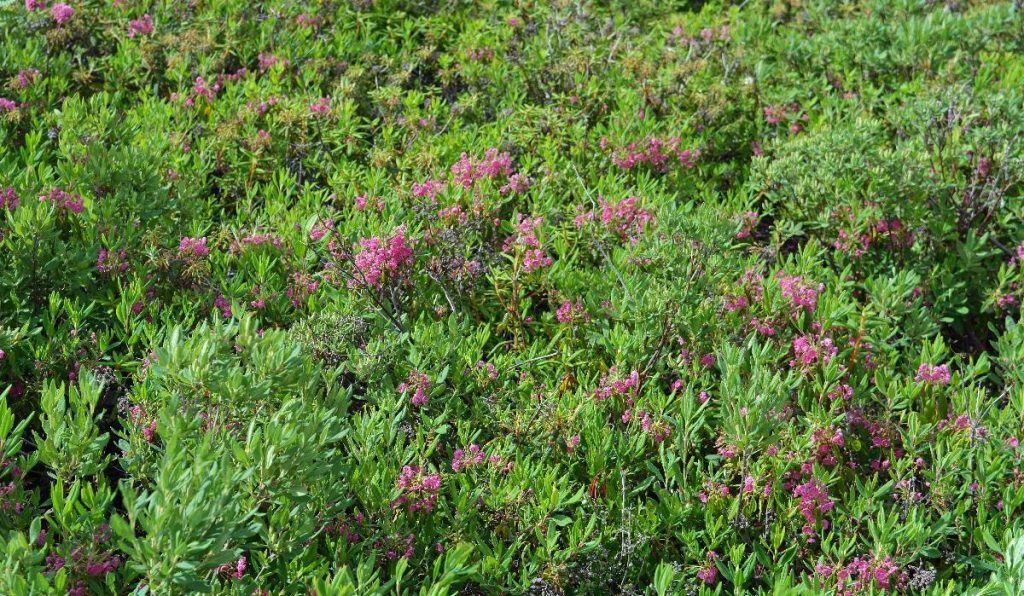Introduction
Sheep Laurel (Kalmia angustifolia) is an excellent choice for your landscaping projects. This versatile evergreen shrub adds beauty and durability to any garden. With its compact size and stunning pink flowers, Sheep Laurel brings visual interest throughout the year.
Choosing the right shrubs for your garden is crucial for successful landscaping. It not only affects the look of your outdoor space but also its long-term sustainability. Sheep Laurel meets this need by providing:
- Year-round greenery
- Adaptability to different soil types
- Support for local wildlife
- Low maintenance needs
This guide will explore the key aspects of using Sheep Laurel in your landscape design. You’ll learn about its features, environmental preferences, and practical uses. By understanding these factors, you can make informed decisions about incorporating this native plant into your garden, creating a space that’s both beautiful and environmentally friendly.
Understanding the Characteristics of Sheep Laurel
Sheep Laurel (Kalmia angustifolia) has unique physical features that make it an excellent choice for landscaping projects. This compact evergreen shrub grows to heights of 1-3 feet with a matching spread, creating a balanced and proportional look in garden settings.
Defining Features of Sheep Laurel
The shrub’s defining features include:
- Leathery Blue-Green Leaves: Narrow, lance-shaped foliage measuring 1-2 inches in length, maintaining color throughout all seasons, and arranged in opposite pairs or whorls.
- Striking Flower Display: Deep pink to rose-colored blooms, saucer-shaped flowers in clusters, measuring 0.5 inches in diameter, with peak blooming period from late June to early July.
The plant’s structure creates a dense, rounded form that maintains its shape without extensive pruning. Each branch supports multiple flower clusters, producing a vibrant display during the blooming season. The evergreen nature of Sheep Laurel provides visual interest during winter months when many other plants go dormant.
The combination of compact size, year-round foliage, and stunning summer blooms makes Sheep Laurel an excellent choice for creating permanent structure in garden designs. These characteristics allow it to serve as both a foundation plant and a seasonal showpiece in your landscape.
Environmental Adaptability of Sheep Laurel
Sheep Laurel displays remarkable adaptability across diverse growing conditions, making it a versatile choice for different landscape settings. This hardy shrub thrives in acidic soils with pH levels between 4.5 and 6.0, demonstrating its specialized nature as an acid-loving plant.
Preferred Soil Conditions:
- Consistently moist soil
- Well-draining ground
- Rich in organic matter
- Sandy to clay compositions
- Acidic pH requirements
The plant’s cold-hardiness stands out as a defining characteristic, with successful growth documented across USDA Zones 1-7. This extensive range spans from the frigid temperatures of -50°F (-45.6°C) to the moderate climates of Zone 7, reaching 0°F (-17.8°C).
Sheep Laurel adapts to challenging environments where other plants might struggle:
- Boggy wetlands
- Sandy coastal areas
- Rocky outcrops
- Woodland edges
- Rain gardens
You’ll find this resilient shrub flourishing in both full sun and partial shade locations. In warmer regions, providing afternoon shade helps protect the plant from intense heat. The key to successful growth lies in maintaining consistent soil moisture without waterlogging the roots.
This adaptability to varied conditions makes Sheep Laurel an excellent choice for naturalized gardens and areas where soil conditions might limit other plant options. The plant’s tolerance for wet conditions particularly suits it to rain gardens and areas with seasonal flooding.
Landscaping Uses for Sheep Laurel
Sheep Laurel is a versatile plant that can be used in various ways to enhance your outdoor spaces. Here are some of the ways you can incorporate Sheep Laurel into your landscaping design:
1.Mass Plantings
One of the most effective ways to use Sheep Laurel is by creating mass plantings. This involves grouping several shrubs together to establish a cohesive ground cover. Not only does this add visual impact to your landscape, but it also reduces maintenance needs.
2. Specimen Plant
Sheep Laurel can also be used as a specimen plant, where it stands out on its own. Its unique features such as pink saucer-shaped blooms, compact growth habit, year-round foliage interest, and natural appearance make it an attractive focal point in any garden.
3. Naturalized Areas
The shrub excels in naturalized areas, where it seamlessly integrates with existing vegetation. Its native characteristics allow it to establish strong root systems and form sustainable plant communities without competing with other indigenous species.
4. Rain Gardens
Rain gardens can benefit from Sheep Laurel’s adaptability to varying moisture levels. The shrub’s root structure helps filter stormwater runoff, prevent soil erosion, maintain garden stability during heavy rains, and support proper drainage.
5. Specific Garden Types
You’ll find Sheep Laurel particularly effective in:
- Woodland garden edges
- Rock garden features
- Border plantings
- Native plant gardens
- Water-conscious landscapes
6. Smaller Spaces and Informal Hedges
The shrub’s compact size makes it ideal for smaller spaces, while its spreading nature allows it to fill larger areas when planted in groups. Its natural growth pattern creates informal hedges, perfect for defining garden spaces without the rigid appearance of traditional border plants.
Aesthetic Appeal and Ecological Benefits of Sheep Laurel in Landscaping
Sheep Laurel creates stunning visual displays in garden landscapes through its distinctive features. The shrub’s blue-green foliage provides a year-round backdrop, while its pink saucer-shaped flowers burst into vibrant clusters during the summer months. These showy blooms create focal points that draw the eye and add depth to garden designs.
The plant pairs beautifully with complementary native species:
- Low-growing companions: Wild strawberries and native ferns
- Mid-height partners: Winterberry holly and sweet pepperbush
- Taller backdrop plants: Red maple and eastern white pine
Beyond its ornamental charm, Sheep Laurel serves as a vital ecological cornerstone in garden ecosystems. The plant attracts diverse pollinator species, including:
- Native bees
- Butterflies
- Hummingbirds
These pollinators rely on the nectar-rich flowers for sustenance, making Sheep Laurel an essential component of wildlife-friendly gardens. The dense evergreen foliage also provides shelter for small birds during harsh weather conditions.
The shrub’s compact growth habit creates natural transitions between different garden zones, softening hardscape elements and adding texture to borders. Its ability to maintain visual interest across seasons makes it a valuable addition to thoughtfully designed landscapes that prioritize both aesthetics and ecological benefits.
Maintenance Requirements for Healthy Growth of Sheep Laurel Shrubs
Sheep Laurel thrives with minimal maintenance when planted in suitable conditions. Here’s what you need to know about caring for these resilient shrubs:
Watering Requirements
- Water deeply but infrequently to establish strong root systems
- Maintain consistent soil moisture without waterlogging
- Reduce watering during winter months
Pruning Guidelines
- Remove dead or damaged branches in early spring
- Shape the shrub after flowering to maintain desired size
- Cut back overgrown stems to promote bushier growth
Soil Care
- Apply a 2-inch layer of organic mulch to retain moisture
- Keep mulch away from the base of the stems
- Test soil pH annually to maintain acidic conditions
Disease Prevention
- Space plants properly to ensure good air circulation
- Remove fallen leaves and debris around the base
- Monitor for signs of leaf spots or fungal issues
Sheep Laurel plants respond well to light fertilization with an acid-forming fertilizer in early spring. A balanced approach to maintenance helps these shrubs maintain their natural beauty and vigor throughout the growing season.
Conclusion: Embracing Sustainable Landscaping Practices with Sheep Laurel Shrubs
Sheep Laurel is a perfect example of sustainable landscaping done right. This native shrub brings multiple benefits to your garden:
- Natural adaptation to local conditions
- Minimal water requirements
- Support for local wildlife and pollinators
- Year-round visual interest
By choosing Sheep Laurel for your landscape, you’re creating an eco-friendly garden that maintains itself with minimal intervention. The shrub’s resilience and natural beauty make it an ideal choice for gardeners committed to ecological gardening practices. Your decision to incorporate this native plant helps preserve local biodiversity while creating a stunning, sustainable landscape that future generations can enjoy.

